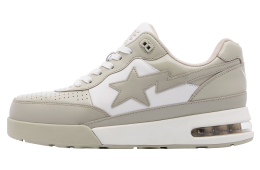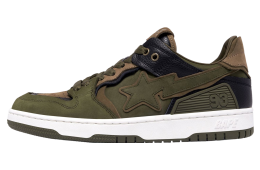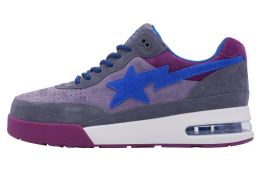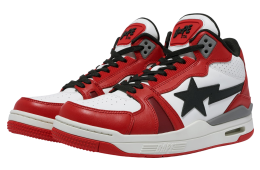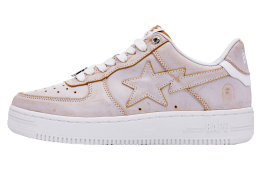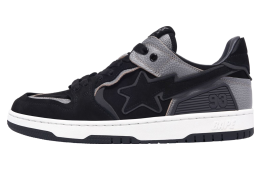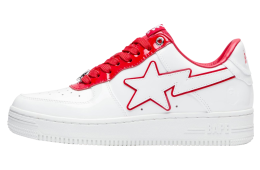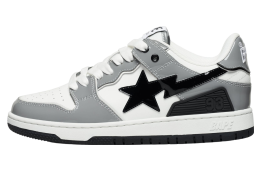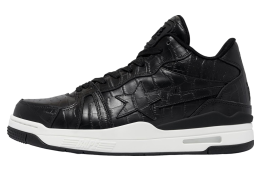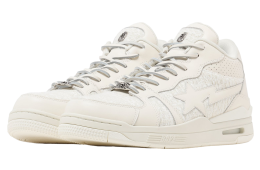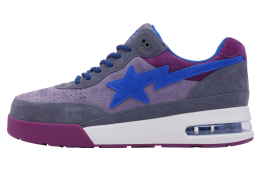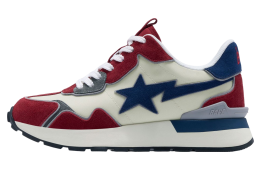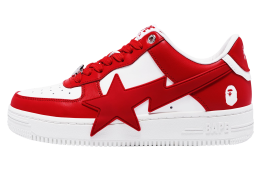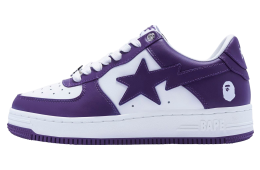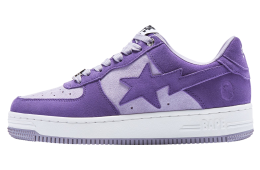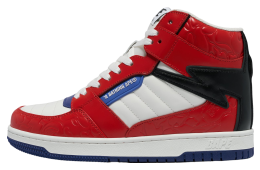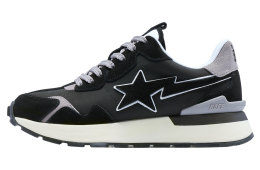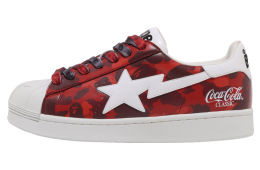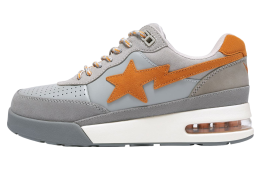Bape
Bape, also known as A Bathing Ape, is a Japanese streetwear brand founded by designer Nigo in Ura-Harajuku, Tokyo, in 1993. The brand quickly became a pioneer in the streetwear scene, known for its vibrant and eclectic designs that seamlessly merged Japanese pop culture with Western influences. The brand's signature camo patterns, shark hoodies, and bold use of graphics have made it highly coveted among fashion enthusiasts worldwide. Beyond apparel, Bape has ventured into various collaborations with numerous iconic brands and artists, from Coca-Cola to Kanye West, further cementing its status as a cultural phenomenon.
Over the years, Bape has expanded its footprint significantly, establishing flagship stores across major global cities, including New York, London, and Hong Kong. The brand's distinctive aesthetic, characterized by its playful yet edgy approach, continues to resonate with a diverse audience, from skate culture aficionados to high-fashion consumers. Despite changes in ownership—most notably, its acquisition by Hong Kong-based fashion conglomerate I.T in 2011—Bape has maintained its innovative spirit and influential presence in the fashion industry. Today, it stands as a testament to the enduring appeal of streetwear, constantly reinventing itself while staying true to its roots.
read moreHistory of Bape
The History of Bape: A Pioneering Force in Streetwear Fashion
Introduction
Bape, short for A Bathing Ape, has cemented itself as a cornerstone of streetwear fashion. The journey of Bape from a local brand in Japan to a global phenomenon is a fascinating tale of vision, culture, and fashion evolution. Founded by Nigo in 1993, the brand boasts a legacy of bold designs, high-profile collaborations, and an indelible impact on the fashion industry. This history delves into the various facets of Bape's ascent, covering its origins, iconic motifs, global expansion, and cultural influence.
Origins: Nigo, the Visionary
The genesis of Bape is closely interwoven with the life and vision of its founder, Tomoaki Nagao, better known as Nigo. Born on December 23, 1970, in Maebashi, Gunma Prefecture, Japan, Nigo demonstrated an early passion for fashion and music, particularly American hip-hop culture. After studying fashion editing at Bunka Fashion College in Tokyo, Nigo immersed himself in the city's vibrant youth culture.
Nigo’s foray into the fashion world began modestly. He initially worked as an editor and stylist for Popeye, a Japanese fashion magazine. During this time, he befriended Jun Takahashi, the future founder of the brand Undercover. These connections were instrumental in shaping his future endeavors.
In 1993, Nigo opened a small shop called "Nowhere" in the Harajuku district of Tokyo alongside Takahashi. The store's initial concept was more than just retail; it was a cultural hub that drew heavily from Tokyo's burgeoning street culture. Energized by the positive reception and driven by an unyielding creative spark, Nigo introduced his own brand, A Bathing Ape, shortly thereafter.
The Name and Logo: Crafting a Unique Identity
Bape’s name is a clever amalgam of cultural references and personal ethos. "A Bathing Ape" is derived from the Japanese expression "a bathing ape in lukewarm water," which alludes to a sense of complacency and indulgence. This reflective critique of contemporary youth culture is mirrored in Bape’s audacious and often ironic design philosophy.
The brand’s logo, featuring a stylized ape head, is a nod to the classic sci-fi movie "Planet of the Apes." The imagery is both bold and enigmatic, encapsulating the brand’s spirit of rebellion and adventure. This distinctive logo has since become a highly coveted emblem among fashion enthusiasts worldwide.
Iconic Designs and Motifs
One of the critical factors behind Bape's enduring popularity lies in its signature designs and motifs. From the very beginning, the brand embraced vivid, flamboyant aesthetics. Standout elements include:
Camouflage Patterns
Bape's unique take on camouflage patterns is perhaps its most recognizable design hallmark. Unlike traditional military camo, Bape's version incorporates vibrant colors and often integrates the ape head logo within the pattern, creating an eye-catching visual that stands apart.Shark Hoodies
Introduced in the mid-2000s, Bape's shark hoodies have become an iconic symbol of the brand. Featuring a full-zip hoodie with a menacing shark face that encompasses the entire hood, this design blends streetwear sensibilities with a playful touch of menace and anonymity.Bapesta Sneakers
The Bapesta sneaker is another pillar of Bape’s product line. Launched in the early 2000s, Bapestas bear a striking resemblance to Nike's Air Force 1s but are accentuated with the signature Bape star logo. Their colorful, patent leather iterations have made them a must-have for sneakerheads.Expansion and Collaborations
As Bape's reputation grew locally, Nigo set his sights on global expansion. The brand’s first international flagship store opened in New York City in 2005, signaling its entry into the Western market. Subsequent stores in global fashion capitals like London and Paris further solidified its presence.
Bape’s global ascent was catalyzed by strategic collaborations with other well-known brands and celebrities. Some notable partnerships include:
Pharrell Williams
One of Bape's earliest and most impactful collaborations was with American musician and fashion icon Pharrell Williams. Pharrell's brand, Billionaire Boys Club (BBC), was closely tied with Bape, with Nigo playing a crucial role in its design and branding. This alliance significantly boosted Bape's visibility in the American market.Supreme
The collaboration between Bape and Supreme in 2002 remains a landmark moment in streetwear history. Supreme, another pioneer in the domain, shared a similar ethos of blending rebellious youth culture with high-fashion sensibilities. Their joint releases have since become grail pieces for collectors.Adidas
In 2003, Bape collaborated with Adidas, merging Bape’s signature camouflage patterns with Adidas' classic silhouettes. The resulting sneaker collections, including iterations of the Superstar and NMD models, enjoy a cult following to this day.High-End Fashion Collaborations
Bape has also ventured into high-end fashion through collaborations with luxury brands such as Coach and Comme des Garçons. These partnerships exhibit the brand’s versatility and its ability to seamlessly blend streetwear with luxury fashion.Cultural Impact
Bape’s influence extends beyond the realm of fashion; it has permeated various facets of popular culture. The brand’s deep ties with the music industry, particularly hip-hop, have played a central role in amplifying its cultural footprint.
Hip-Hop Affiliations
Nigo’s friendship with influential hip-hop artists like Pharrell Williams, Kanye West, and Jay-Z has translated into organic endorsements that resonated with fans. References to Bape in song lyrics and appearances in music videos have significantly bolstered the brand's cachet.Streetwear Community
Bape has contributed to the rise of streetwear as a mainstream fashion category. The brand’s high-profile collaborations and limited-release model have inspired a generation of streetwear brands to adopt similar strategies. The sense of exclusivity and community fostered by Bape has set a precedent for contemporary streetwear culture.Bape Heads Show
The “Bape Heads Show” is an annual event that showcases the brand's latest collections, often featuring performances by leading hip-hop artists and other cultural icons. These events are not just fashion shows but cultural spectacles that underscore Bape’s symbiotic relationship with music and youth culture.Challenges and Evolution
Despite its sustained popularity, Bape has not been immune to challenges. The brand has faced issues related to counterfeiting, market saturation, and changing fashion trends. However, Bape has demonstrated remarkable resilience and adaptability.
Counterfeiting
Bape’s immense popularity has made it a prime target for counterfeiters. The proliferation of fake Bape products prompted the brand to implement various measures to combat this issue, including the use of authentication tags and more stringent quality control.Market Shifts
As streetwear has become more mainstream, the market has seen an influx of new brands vying for consumer attention. To stay relevant, Bape has continually evolved its product offerings and marketing strategies. The brand has embraced e-commerce and social media to engage with a younger audience, ensuring its continued relevance.Leadership Transition
In 2013, Nigo stepped down as the creative director of Bape, marking the end of an era. Despite concerns about the brand's future, Bape has continued to thrive under new leadership. Nigo's departure allowed for fresh creative visions while maintaining the brand’s core identity.Bape Today
Under the new creative leadership, Bape has continued to innovate and expand. The brand has ventured into new territories, including women's and children's wear, and has maintained a robust presence in the global market. Bape has also embraced the digital age, with an active online store and a strong social media presence that keeps it connected with its global fanbase.
Eco-Friendly Initiatives
In recent years, Bape has made efforts to adopt more sustainable practices in line with global trends towards eco-conscious fashion. From using organic materials to implementing more sustainable manufacturing processes, Bape is taking steps to reduce its environmental footprint.Continuing Legacy
Bape's enduring influence is evident in its continued popularity among new generations of fashion enthusiasts. The brand's ability to stay relevant in a rapidly changing fashion landscape is a testament to its solid foundation and innovative spirit.Conclusion
Bape's journey from a small store in Harajuku to a global streetwear icon is a remarkable narrative of vision, innovation, and cultural synergy. Nigo's unique approach to fashion—blending Japanese street culture with American hip-hop influences—created a brand that transcends geographical and cultural boundaries. Through its iconic designs, strategic collaborations, and deep-rooted connections with music and youth culture, Bape has left an indelible mark on the fashion industry. As it continues to evolve and adapt, Bape remains a pioneering force in streetwear, inspiring future generations of designers and fashion enthusiasts worldwide.

